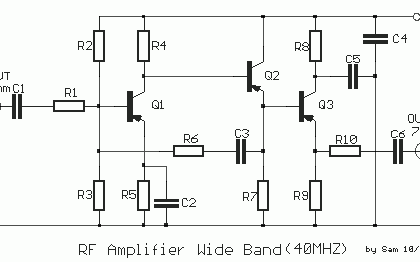
Rf (Radio)

A noise generator with a wideband output signal is useful for adjusting receivers and various types of HF equipment.
A noise generator is an essential tool in the field of electronics, particularly for testing and troubleshooting radio frequency (RF) equipment. It produces a wideband noise signal that can be utilized to simulate various RF conditions. This capability is particularly beneficial for aligning and calibrating receivers, amplifiers, and other HF devices, ensuring they perform optimally under varying signal conditions.
The circuit typically consists of a simple oscillator that generates white noise, which is then amplified and filtered to produce a stable output. Common components used in such a circuit include transistors, resistors, capacitors, and sometimes operational amplifiers to enhance the noise signal. The oscillator can be designed using a variety of methods, such as using a Zener diode or a noise transistor, which provides a reliable source of noise.
The output of the noise generator can be connected to the input of the equipment under test. This allows engineers and technicians to evaluate the performance of RF components by observing how they respond to the generated noise. Adjustments can be made based on the output characteristics, ensuring the equipment is properly tuned for optimal performance.
In summary, a noise generator with a wideband output signal is a versatile instrument that aids in the maintenance and calibration of HF equipment, facilitating better performance and reliability in communication systems.A noise generator with a wideband output signal is always handy to have around when you`re adjusting receivers and other types of HF equipment. Simple RF Noise Source Circuit Diagram: read more †’ 🔗 External reference
A noise generator is an essential tool in the field of electronics, particularly for testing and troubleshooting radio frequency (RF) equipment. It produces a wideband noise signal that can be utilized to simulate various RF conditions. This capability is particularly beneficial for aligning and calibrating receivers, amplifiers, and other HF devices, ensuring they perform optimally under varying signal conditions.
The circuit typically consists of a simple oscillator that generates white noise, which is then amplified and filtered to produce a stable output. Common components used in such a circuit include transistors, resistors, capacitors, and sometimes operational amplifiers to enhance the noise signal. The oscillator can be designed using a variety of methods, such as using a Zener diode or a noise transistor, which provides a reliable source of noise.
The output of the noise generator can be connected to the input of the equipment under test. This allows engineers and technicians to evaluate the performance of RF components by observing how they respond to the generated noise. Adjustments can be made based on the output characteristics, ensuring the equipment is properly tuned for optimal performance.
In summary, a noise generator with a wideband output signal is a versatile instrument that aids in the maintenance and calibration of HF equipment, facilitating better performance and reliability in communication systems.A noise generator with a wideband output signal is always handy to have around when you`re adjusting receivers and other types of HF equipment. Simple RF Noise Source Circuit Diagram: read more †’ 🔗 External reference